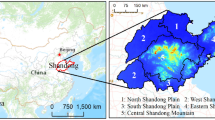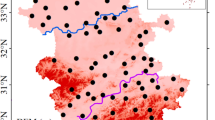Abstract
The exploratory spatial data analysis (ESDA) method, which includes global spatial autocorrelation and local spatial autocorrelation, is used to analyze the spatial pattern of the annual grain production and annual grain production increment in the Ziya River Basin from 2007 to 2017. Then, the spatial mismatch index is used to analyze the spatial mismatch relationship between the annual grain output and annual precipitation in the Ziya River Basin in 2015. The results showed that (1) the spatial pattern of the annual grain production in the Ziya River Basin is stable, with Low-Low clusters and High-High clusters concentrated on the left and right sides of the Ziya River Basin, respectively. The overall difference in the annual grain production of each district and county increased gradually from 2013 to 2017. (2) The local spatial correlation structure of the annual grain production of adjacent districts and counties in the Ziya River Basin had strong stability, and its space-time transition had a certain path dependence or spatial-locking characteristics. The reason why the High-High clusters are concentrated on the right side of the Ziya River is that there are large cultivated areas, such as the Shijin irrigation district, on the right side of the Ziya River Basin. (3) A spatial change rule “the proportion of grain production is low and the proportion of rainfall is high” changed to “the proportion of grain production and rainfall is balanced” and then to “the proportion of grain production is high and the proportion of rainfall is low” in the Ziya River Basin in 2015. The Shijin irrigation district is mainly located in the area where the spatial mismatch between the annual grain output and the average annual rainfall in the Ziya River Basin in 2015 is assessed as grade V, which indicates that the spatial mismatch between the annual grain output and the annual average rainfall is serious. In summary, grain production in the Shijin irrigation district has been increasing annually, while the supply of water for irrigation has not increased as much. There is a serious deficit between the irrigation water supply and the water demand for grain production in the Shijin irrigation district. Therefore, it is necessary to plan for the development and utilization of surface water and groundwater resources and to adjust the planting structure in the Shijin irrigation district for the purpose of saving water.







Similar content being viewed by others
Data Availability
The datasets used or analyzed during the current study are available from the corresponding author upon reasonable request.
References
Anselin, L. (1995). Local indicators of spatial association—LISA. Geographical Analysis, 27(2), 93–115.
Arndt, C., Robinson, S., & Willenbockel, D. (2011). Ethiopia’s growth prospects in a changing climate: a stochastic general equilibrium approach. Global Environmental Change, 21(2), 701–710.
Asseng, S., Foster, I., & Turner, N. C. (2011). The impact of temperature variability on wheat yields. Global Change Biology, 17(2), 997–1012.
Basso, B., Fiorentino, C., Cammarano, D., Cafiero, G., & Dardanelli, J. (2012). Analysis of rainfall distribution on spatial and temporal patterns of wheat yield in Mediterranean environment. European Journal of Agronomy, 41, 52–65.
Beyer, M., Wallner, M., Bahlmann, L., Thiemig, V., Dietrich, J., & Billib, M. (2016). Rainfall characteristics and their implications for rain-fed agriculture: a case study in the upper Zambezi River basin. Hydrological Sciences Journal-Journal des Sciences Hydrologiques, 61(2), 321–343.
Broberg, M. C., Hogy, P., Feng, Z. Z., & Pleijel, H. (2019). Effects of elevated CO2 on wheat yield: non-linear response and relation to site productivity. Agronomy-Basel, 9(5), 243.
Grzegozewski, D. M., Uribe-Opazo, M. A., Johann, J. A., & Guedes, L. P. C. (2017). Spatial correlation of soybean productivity, enhanced vegetation index (EVI) and agrometeorological variables. Engenharia Agricola, 37(3), 541–555.
Liu, X. H., & Wang, J. F. (2002). Analysis and application on the specification methods of the spatial weight matrix. Geo-information Science, 4(2), 38–44.
Lu, F., & Xu, J. (2007). Exploratory spatial data analysis of the regional economic disparities in China. Journal of East China Normal University (Natural Science), 2, 50–57.
Martin, R. W. (2001). The adjustment of black residents to metropolitan employment shifts: how persistent is spatial mismatch? Journal of Urban Economics, 50, 52–76.
Martin, R. W. (2004). Spatial mismatch and the structure of American Metropolitan areas, 1970-2000. Journal of Regional Science, 44, 467–488.
Mitra, S. K. (2014). Nonlinear impact of rain on food grain production in India. Applied Economics Letters, 21(14), 1001–1005.
Ping, J. L., Green, C. J., Zartman, R. E., & Bronson, K. F. (2019). Exploring spatial dependence of cotton yield using global and local autocorrelation statistics. Field Crops Research, 89(2–3), 219–236.
Porter, J. R., & Semenov, M. A. (2005). Crop responses to climatic variation. Philosophical Transactions of The Royal Society B-Biological Sciences, 360(1463), 2021–2035.
Rey, S. J. (2001). Spatial empirics for economic growth and convergence. Geographical Analysis, 33(3), 195–214.
Santos de Araujo, M. L. S., Sano, E. E., Bolfe, E. L., Santos, J. R. N., Dos Santos, J. S., & Silva, F. B. (2019). Spatiotemporal dynamics of soybean crop in the Matopiba region, Brazil (1990-2015). Land Use Policy, 80, 57–67.
Sujariya, S., Jongrungklang, N., Jongdee, B., Inthavong, T., Budhaboon, C., & Shu, F. K. (2020). Rainfall variability and its effects on growing period and grain yield for rainfed lowland rice under transplanting system in Northeast Thailand. Plant Production Science, 23(1), 48–59.
Wassmann, R., Jagadish, S. V. K., Sumfleth, K., Pathak, H., Howell, G., Ismail, A., Serraj, R., Redona, E., Singh, P. K., & Heuer, S. (2009). Regional vulnerability of climate change impacts on Asian rice production and scope for adaptation. Advances in Agronomy, 102, 91–133.
Xia, P. Y., Ying, G. E., Hua, M. R., et al. (2005). Analyzing regional economic disparities based on ESDA. Geographical Research, 24(6), 965–974.
Zhu, W. B., Jia, S. F., Devineni, N., Lv, A. F., & Lall, U. (2019). Evaluating China’s water security for food production: the role of rainfall and irrigation. Geophysical Research Letter, 46(20), 11155–11166.
Code availability
Not applicable
Funding
The authors receive financial support from the National Natural Science Foundation of China (grant no. 51879181).
Author information
Authors and Affiliations
Contributions
All the authors contributed to the study conception and design. Material preparation, data collection, and analyses were performed by Fawen Li, Yachen Wang, and Runxiang Cao. The first draft of the manuscript was written by Yachen Wang and all the authors commented on previous versions of the manuscript. All the authors read and approved the final manuscript.
Corresponding author
Ethics declarations
Conflict of interest
The authors declare that they have no conflicts of interest.
Additional information
Publisher’s note
Springer Nature remains neutral with regard to jurisdictional claims in published maps and institutional affiliations.
Rights and permissions
About this article
Cite this article
Li, F., Wang, Y. & Cao, R. Spatial pattern matching analysis of grain production and rainfall in the Ziya River Basin. Environ Monit Assess 193, 88 (2021). https://doi.org/10.1007/s10661-021-08866-w
Received:
Accepted:
Published:
DOI: https://doi.org/10.1007/s10661-021-08866-w




